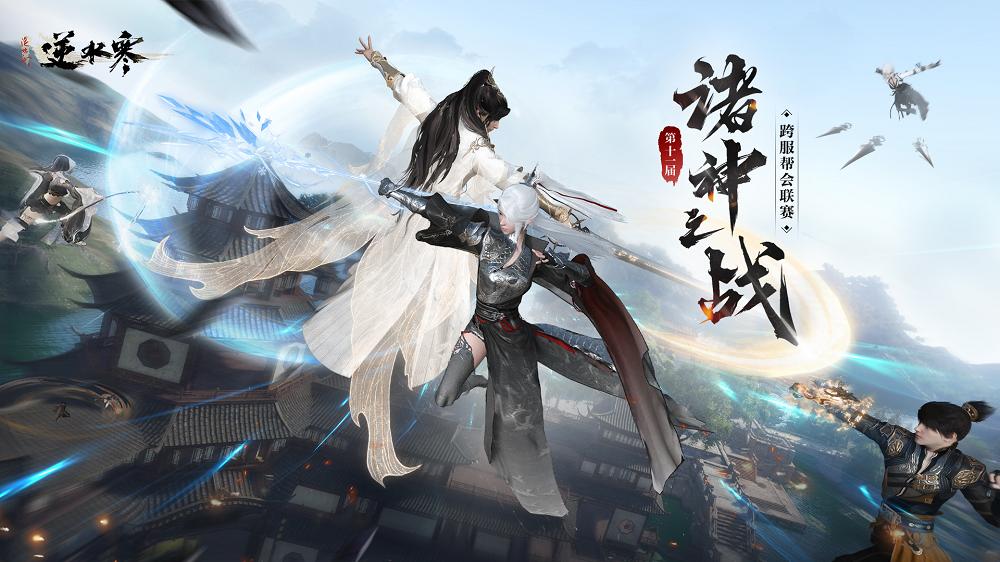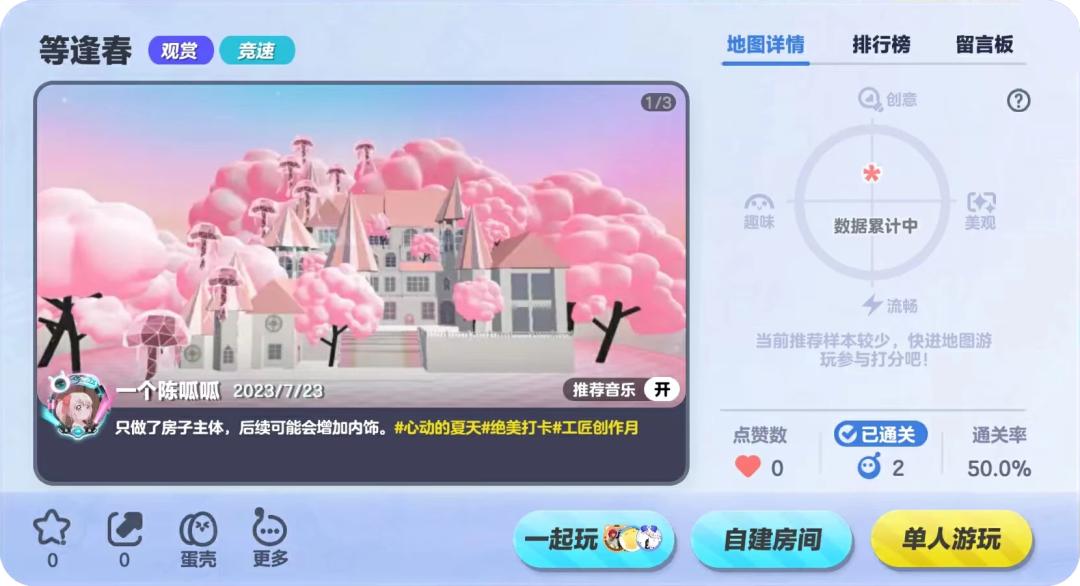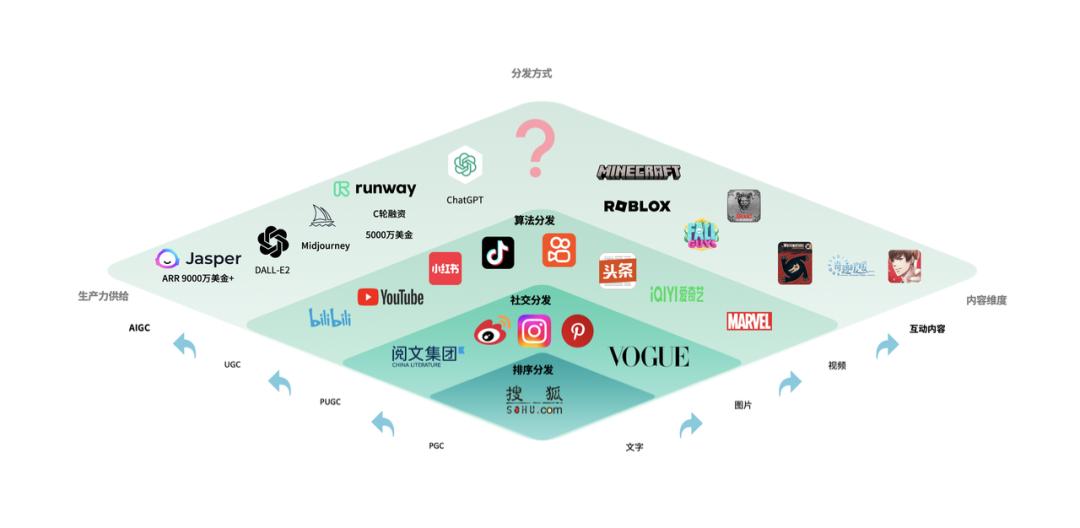What New Opportunities Did AI Bring to the Gaming Industry in 2023?
-
2023 marked the explosive rise of AI-powered games.
'Eggy Party,' supported by AI, had a standout moment at the beginning of the year—surpassing 30 million daily active users (DAU), making it NetEase's highest-DAU game. By August, its monthly active users exceeded 100 million. Meanwhile, 'Justice Online,' launched in June, introduced interactive and 'emotionally responsive' NPCs, achieving over 2 billion yuan in revenue in its first month.
On the content production side, AI's advancement has been unstoppable. According to the '2023 Gaming Industry Mid-to-High-End Talent Insights' report by Maimai HighPin, nearly 95% of gaming professionals are actively embracing AI, with over one-fifth already treating AI tools as work partners. Additionally, players are increasingly using AI tools to participate in content creation, enabling an endless cycle of content supply and consumption.
Amid the surge of AI-driven games, we invited Bai Zhi (CEO of Funmangic), Wu Feng (CTO of Funmangic), Mr. Yang (a leading esports PC game brand publishing executive), and Fan Mingwang (early-stage project lead at FreeS Fund) to discuss how AI is reshaping the gaming industry.
Bai Zhi, founder of Funmangic, previously served as the metaverse incubation lead at ByteDance and was the chief planner for 'Love and Producer.' Her company, Funmangic, is developing an AI-driven social product centered around gaming content.
Wu Feng, CTO of Funmangic, was formerly the head of NetEase's Fenglei Studio and the product lead for NetEase Fuxi AI Platform. NetEase Fuxi has supported major IPs like 'Chinese Ghost Story,' 'Justice Online,' and 'Naraka: Bladepoint,' all of which have explored AI applications extensively.
Mr. Yang is a senior gaming industry professional and the publishing lead for a top-tier esports PC game brand.
Fan Mingwang, Early Project Leader at Fengrui Capital, focuses on three major areas: consumer, TMT, and entertainment.
They discussed topics including but not limited to:
We have edited part of their discussion into this article, hoping to provide new perspectives. We welcome everyone to continue observing and discussing with us.
Fan Mingwang: Currently, at what stage is the application of AI technology in the gaming industry? What is its current state and future development?
Wu Feng: In fact, the integration of artificial intelligence and gaming did not start this year, but it has received special attention this year because generative AI has developed very rapidly. As we say, the world changes after a nap.
For example, NetEase Fuxi was established in 2017 and was the first in China to attempt AI + gaming. Justice Online Mobile has shown its achievements. However, these achievements are inseparable from NetEase's five years of dedication and effort in the MMO (Massive Multiplayer Online Role-Playing Game) field. Therefore, when AI became popular, NetEase was able to quickly integrate AI with gaming and achieve results in application.

From the earliest days of gaming, there have been computer-controlled NPCs (Non-player characters). We refer to the behavioral engines of these NPCs as AI. However, this AI is deterministic and pre-programmed. When we play games like 'Super Mario', all non-player controlled units are called NPCs. For example, the turtles in the game move back and forth in place with their own behavioral patterns.

This represents the first phase of AI application in games. These pre-programmed logic units based on behavior trees or state machines are what we call AI.
The second stage is the 'deep learning' phase. For example, in the game Naraka: Bladepoint, which features a highly dynamic, fully 3D environment, how can NPC opponents perform as skillfully as human players? We use reinforcement learning methods to drive highly competitive and human-like AI opponents. Simply put, this makes the NPCs in the game behave more like humans in terms of combat mechanics and gameplay.
In games like Honor of Kings and League of Legends, AI-controlled heroes are designed to be as agile and strategic as those controlled by players. Similarly, AlphaGo is a classic example of a deep learning-based adversarial AI, using reinforcement learning to achieve human-level competitive abilities in the game of Go.

The third stage focuses on making NPCs' speech and behavior more human-like. Language is the most challenging aspect of AI. With the advent of generative AI, we now have the capability to create NPCs in games with distinct personalities, goals, and behavioral patterns, making them more lifelike and personalized.
Justice Online is a prime example of this gameplay. NPCs now have their own objectives, emotions, and personalities, capable of engaging in natural conversations with players and even developing complex relationships. Each player's experience with NPCs is unique and cannot be pre-scripted or coded.
To summarize, the application of AI in NPCs can be divided into three stages. The first stage involves traditional behavior trees or state machines, representing a coding-oriented artificial intelligence approach. The second stage introduces deep learning and reinforcement learning, focusing on adversarial and decision-making robots. The third stage, with the emergence of generative large language models, has given rise to personalized robots like the intelligent NPCs in Justice Online.
We may currently be in the midst of a 'storm,' with more blockbuster games expected to emerge in the market. Our production relationships will also undergo more intense changes and impacts. However, we remain optimistic, believing there are many new opportunities ahead.
Teacher Yang: To add to the three stages mentioned earlier, in the second stage, AI not only excels at creating adversarial robots but also leverages big data to help us understand games. For example, Dota 2 has a membership system that uses big data to recommend skills to learn, talents to choose, and items to buy during gameplay, which greatly assists players.
Fan Mingwang: I have a question for Teacher Wufeng. Some players, after developing emotional bonds with AI, feel disappointed when they log in later and find that the NPC doesn’t remember their previous conversations. I wonder if future technology can help AI better remember interactions with players. Are there any latest research findings or technological pathways in this area?
Wufeng: This is definitely achievable. Long-term memory, more nuanced emotional analysis, and safety are the core competencies in the AI application race. This is also what we at Funmangic aim to achieve—creating an NPC society and AI social gaming experience with emotions, moods, and souls. The trade-offs behind this depend on whether we have enough debugging keywords, sufficient computing power, and a sufficiently good and large model to truly bring it to engineering fruition.
Personally, I'm more ambitious and believe that artificial general intelligence (AGI) will arrive sooner. AI has the potential to introduce NPCs with souls and personalities into gaming experiences, creating immersive virtual societies.
Though it remains a "brain in a vat" (a classic thought experiment exploring whether a brain could recognize its existence in a simulated reality if all its experiences were artificially generated), it won't be like Westworld, where characters physically step off a train to interact in a real-world setting.

Still from Westworld. Image source: Douban MovieToday's AI can already pass the Turing Test, making it difficult to distinguish between human and AI interactions. The long-term significance lies in AI potentially developing lasting memories and nuanced emotions, becoming entities with true personality and soul—this is what we in the industry strive to achieve.
Baizhi: General-purpose AI like GPT leans more toward being a tool and struggles to form deep emotional connections with users. We aim to create AI social experiences through gamification, developing virtual AI characters with souls to accompany users. While practical, these AI companions can also provide emotional resonance, helping socially anxious or introverted individuals navigate social interactions with AI-created NPCs.
Most products on the market currently focus on text-based interactions. When we have 3D virtual avatars, we also want NPCs to align their words with actions, where behavioral patterns and dialogue systems are powered by the same Large Language Model (LLM). This way, during interactions with players, NPCs can continuously learn and train, developing a more self-consistent logic. As a result, they may become AI with a 'soul' in the virtual world.
Regarding long-term memory, we've had numerous internal discussions. We believe long-term memory is an essential prerequisite for digital life. It should be able to retain memories spanning over seven days based on user intimacy. We hope that when users return to this virtual world or product, NPCs can recall memories from one year, five years, or even ten years ago, remembering those truly meaningful and special moments shared with players, potentially even connecting to their real-life experiences.
Wufeng: Earlier, I mentioned that AI is like a 'brain in a vat,' but in games, it's not. Traditional large language models are cognitive models with extensive knowledge and common sense, functioning as probability prediction models. However, they lack concepts of right and wrong, unaware of the physical world's rules or correctness.
But in the gaming world, by introducing decision models and factors into cognitive model training, we can achieve complementary cognition and decision-making, allowing them to train each other in a fully digital environment. This is why I believe general artificial intelligence and gaming will inevitably merge first, implement first, and develop first—because it combines decision-making capabilities with cognitive abilities, something traditional single-language models cannot achieve.
Teacher Yang: Shouldn't AI have better memory than normal humans? Why worry about AI's long-term memory issues?
Wu Feng: It actually carries different meanings. Current large language models possess exceptional memory capacity - they've essentially memorized nearly all of human civilization's knowledge. This represents one level of memory, which isn't tied to any individual.
However, within this vast memory, as Bai Zhi mentioned earlier, personal interactions between two people would get drowned in the ocean of human historical knowledge if trained in the base model. This isn't a problem that can be solved from the base model's perspective, but rather requires solutions from middleware and upper-layer applications.
Teacher Yang: Is it because the model inherently lacks emotions, so when searching for correct answers, it gets confused by its massive stored information?
Wu Feng: Exactly. If you want certain information to be retrievable in the language model, it requires extensive training with large datasets. But individual data and collective data exist on completely different scales.
Fan Mingwang: This year we've seen games like "The Legend of Nie Xiaoqian" and "Justice Online" develop new gameplay features around AI. Additionally, "Eggy Party" utilizes AIGC technology to lower the threshold for user-generated content.
Currently in the gaming industry, we're observing more instances where user-generated content gameplay duration surpasses that of built-in main gameplay. How do you view the impacts and transformations that AI technology is bringing to the gaming industry's production capabilities?
Eggy Party: This is a casual lightweight social role-playing game and NetEase's product with the highest DAU in history, recently surpassing 100 million monthly active users. Its UGC content ecosystem is deeply integrated with AI, forming a user-co-created content environment.

A standout feature of this game is its low barrier to entry. Regardless of gaming experience, all users can participate in Eggy Party. The game provides UGC creation tools - skilled players can design custom maps, while casual players can enjoy maps created by others.

During the iteration of its UGC (User-Generated Content) map editing features, Eggy Party has also introduced AI-assisted map creation tools. The game already boasts a creator base in the tens of millions, with weekly UGC map updates reaching the hundreds of thousands. In the future, more creators may be inclined to use AI for assisted content creation.
Teacher Yang: There's another significant aspect to this. Without AI, UGC remains strictly UGC, and PGC (Professionally Generated Content) stays as PGC. With AI integration, the barrier to UGC is lowered. PGC creators may no longer need to produce content directly but can instead provide "possibilities." More authors can leverage developer-provided resources and AI to create UGC content more easily.
Currently, UGC content is centralized—some create while most only consume. With AI lowering the creation threshold, users can fulfill their in-game needs themselves rather than waiting for skilled creators to produce content they desire.
Fan Mingwang: For game industry professionals, especially concept artists (who create hand-drawn key character designs and actions for animation and video games), how do they view the trend of AI tools and increasing AIGC (AI-Generated Content) integration in games?
Wufeng: This is a particularly interesting topic. On a deeper level, this represents a shift in production relations—players transitioning from pure consumers to creators. Traditional creators in the gaming industry will indeed face challenges.
This change in production relations closely resembles the First Industrial Revolution, when the spinning jenny replaced textile workers. Although the spinning jenny represented advanced productivity, it was angrily destroyed and burned by thousands of unemployed textile workers at the time.
Artists can't burn AI, but the impact is indeed happening. We saw significant backlash from the artist community when AI-generated art first entered competitions. Recently, during the release of the movie Oppenheimer, Hollywood writers and actors went on strike, protesting and resisting AI-generated content.
For professionals, this change is undoubtedly a double-edged sword—is AI a tool or a replacement for humans? Reflecting on the spinning jenny, it replaced manual laborers, but no one expected AI to first replace intellectual workers. However, this doesn’t mean complete replacement but rather adaptation. For instance, artists must now learn AI creation and model training.
Fan Mingwang: In the future, will existing roles in art and creative work evolve or iterate with the development of AIGC technology?
Teacher Yang: Right now, we might feel that AI is competing with writers and artists for jobs, but in the future, new professions will emerge. There may be roles like AI trainers, which could require further specialization.
Recently, I returned to my alma mater and noticed many students in environmental and materials science, after completing their master's or PhD, have transitioned into coding. In the future, art students might become AI trainers, but that doesn’t mean they can’t continue painting. I’m optimistic about this issue. People may resist for a better life at first, but eventually, they’ll accept and adapt.
Fan Mingwang: So, as a factor of revolutionary change in productivity and production relations, AI may ultimately become infrastructure, integrated into the development of all industries.
Baizhi: Changes in productivity and tools drive human progress. Humans excel at using tools, from making fire to using smartphones, and now even employing GPT for basic tasks. AI is a new tool; using it well leads to a more comfortable work and life.
Fan Mingwang: How does AI technology impact your team or gaming company? Does it change your company's structure, culture, or productivity?
Baizhi: From a game development perspective, since early this year, concept artists can quickly generate designs from rough sketches. Writers use keywords to visualize worldviews—this applies to art. For 3D art and automated programming, we’ve been experimenting from February to September, but there’s still a gap before it’s player-ready and industrializable.
Wufeng: Technically, I’m highly enthusiastic about this. AI shifts from cost-efficiency to bridging UGC and user creativity, becoming a transformative tool.
Secondly, as I mentioned earlier about the spinning jenny, it didn't become perfect overnight. It went through stages from manual labor to water power, then to steam and electricity. Right now, we feel this 'AI spinning jenny' isn't good enough yet, but we're exploring various ways to improve it, refining the R&D process and production relationships, ultimately aiming for an ideal ecosystem of user co-creation.
Teacher Yang: Adding to this, we've been discussing whether AI's integration into creative workflows would disrupt professionals, but 'Justice Online' hasn't triggered any such backlash. I think this is because it doesn't use pre-generated AI (like the early NPCs in games that could only perform simple actions). Players don't feel anyone is slacking off in the workflow; instead, they recognize the hard work of developers in enhancing the gaming experience, especially in areas like big data and creative content.
Does this mean that real-time generated AI is non-disruptive in the workplace? Or can AI that allows player participation in creation, including dialogue creation, address some of the issues we've observed in the market regarding AI?
Wu Feng: I completely agree. Whether it's screenwriters or the earlier 'NO AI' movements, they often seem like zero-sum games. For example, in a card game, if the card art was originally hand-drawn, players might spend several 648-yuan top-ups (a common in-game purchase limit) to obtain it. Now, if you tell them it's AI-generated with just some electricity cost, consumers find it hard to accept.
'Justice Online' actually offers a new gaming experience that was previously unattainable through static methods. Both consumers and creators are engaging with something entirely fresh.
Sheep Teacher: Teacher Wufeng's insights are quite enlightening. I can even imagine that as players' understanding of AI becomes more established, as a narrative designer, I can creatively and distinctively package certain response keywords to amaze players with remarks like 'I never thought it could say something like that,' thereby further enhancing the gaming experience.
In reality, everything we do is to serve the game, not the concept of AI itself. I believe this is a non-zero-sum approach.
Additionally, as mentioned earlier regarding AI trainers, in such roles, we better define the linguistic framework for NPCs in each scenario. This involves considerable effort and is recognizable. Players can also appreciate the hard work of the designers behind the scenes. I think these are all great inspirations for non-zero-sum game dynamics.
Fan Mingwang: What was just mentioned reminds me of a very similar concept called the 'infinite game.' Traditionally, games have clear boundaries. In a zero-sum competitive relationship, we compete for wins, losses, or rankings, which is the framework for many competitive game genres.
With the introduction of AI and more NPCs into the gaming ecosystem, we are witnessing a shift from finite to infinite gameplay. Many describe 'Justice Online' as a 'super hybrid,' where its core mechanics are hard to pin down, yet every player finds their own unique enjoyment within its world.
Games are becoming increasingly inclusive platforms where every player, including NPCs, is respected for their individuality. This embodies the concept of 'AI for good' mentioned earlier.
Over the past year or two, we've seen numerous innovations combining AI with gameplay. From a player's perspective, what new experiences and challenges does AI bring to gaming?
Wu Feng: 'Justice Online' serves as an early and excellent example, clearing up uncertainties like whether players would chat with NPCs on mobile devices, identifying potential barriers, and exploring technical limitations.
'Justice Online' has also benefited from the fusion of AI and gaming. There's widespread curiosity about how soon 'Westworld' might become reality. The game pioneers new experiences, allowing players to freely interact with NPCs—not scripted entities but intelligent agents (a concept in AI referring to autonomous software or hardware entities). Players can even form emotional bonds, from playful teasing to engagements, creating long-term relationships. Some players have been heartbroken when forgotten by NPCs, inspiring fan fiction and videos that spread online.
These experiences align with long-held expectations, whether from movies like 'Ready Player One' or shows like 'Westworld.' Once a product crosses the threshold of delivering such breakthrough experiences, it naturally generates significant marketing impact.
Fan Mingwang: Teacher Yang has extensive experience in game publishing both domestically and internationally. From a publishing or market perspective, do you think AI has also had an impact on the entire game publishing industry?
Teacher Yang: We can examine this from two aspects: ad buying and game publishing.
On one hand, AI has many applications in ad buying. Simply put, ad buying can be broken down into what to advertise (i.e., content) and how to advertise (i.e., channels).
For content, people can now input key selling points into large AI models to generate various AI videos and banner images, simplifying workflows. This is a change in ad buying.
For channels, this isn’t handled by the gaming industry but by traffic providers like Google, which continuously optimize ad delivery logic using their AI algorithms. Better data means advertisers will continue investing in traffic. With large models, insights are now deeper—for example, discovering that basketball players might prefer World of Warcraft, a correlation previously hard to identify with data alone. Big data and AI models help refine audience segmentation further.
In game publishing, Justice Online uses on-the-fly AI generation, and players don’t reject it, indicating that concerns about game reputation are being addressed. If a game uses AI crudely, leading artists or other professionals to feel their work is disrespected, the resulting backlash could affect player perception. Many in the industry actively avoid this issue.
Fan Mingwang: In the past, we've relied on social relationship-based recommendation algorithms to suggest friends to players. With the introduction of AI technology, do you think there will be new changes in how relationships are distributed within games?
Bai Zhi: We have our own internal social network algorithm, which operates on the principle of an entity value assessment algorithm based on a value flow network. This algorithm views interactions between individuals as a form of value recognition, considering both interactive behaviors and individual characteristics. Within the social network, the algorithm collaboratively evaluates the value between entities, providing foundational support for gamified incentive systems.
We hope AI can continuously create new content to warm up relationships between people and even establish long-term intimate connections. We also aim to quantify intimacy with measurable indicators, recording content that both parties enjoy.
Our OpenRank algorithm can also enhance real-world social relationships. For example, during a chat between two people, it might introduce a relevant meme extracted from the algorithm that connects both individuals. At this level, machine learning based on social networks can better extract entity features from relationships and perform similarity matching in high-dimensional spaces. Through this algorithm, we aim to connect people who may seem like chance encounters but can engage in meaningful conversations.
Fan Mingwang: To put it simply, whether it's the OpenRank algorithm or the new AI-driven algorithm used by Funmangic, they essentially help extract the social assets players leave within the game. This extraction then aids in building connections between strangers or players from different backgrounds. So, it sounds like technology is once again playing a facilitating role, right?
Baizhi: To put it plainly, this is a kind of "AI algorithm matchmaker," but in games, social interactions aren't just one-on-one—they can also bring people together based on shared interests.
Wufeng: In games that emphasize social and linguistic elements, language models naturally complement each other. Whether it's long-term memory or personal interests, these become data that can be understood, summarized, reviewed, and abstracted. Language models and generative models present us with new opportunities to better utilize this data.
Fan Mingwang: The functionality just mentioned reminds me of an episode in the TV series Black Mirror, where everyone's social assets are quantified and displayed above their heads, functioning as a form of social currency.
Expanding on this, more data about personal traits and characteristics could be recorded across games and various products. Could this data genuinely feed back into social interactions beyond gaming? More abstractly, could the social assets accumulated in virtual gaming worlds eventually shape real-world relationships?
Teacher Yang: When you talk about AI collecting this data and feeding it back into real life, I don’t envision anything positive—just scenarios like someone impersonating me to scam my parents for money.
Regarding the latter part of the question, 'Can digital social behaviors enhance real-life social connections?' I believe this is already happening even without AI, especially in highly social games like The Legend of the White Snake and Justice Online, which facilitate many real-life relationships every year. I have several close friends in real life who initially connected through guilds in World of Warcraft. This phenomenon has been ongoing for a while.
At this point, I’m less supportive of AI. I feel that the virtual world has already done a lot of good for us—helping us make friends, find partners, and connect with others in our leisure time. If we scrutinize ourselves more deeply, the possibilities AI offers don’t seem particularly groundbreaking.
Bai Zhi: I think Teacher Yang’s perspective is somewhat limited. For example, a navigation system with Lin Chi-ling’s voice provides a better experience than a robotic one. AI can integrate functionality with emotional value when incorporated into online products.
An AI assistant or AI butler could serve as an alarm clock or reminder, notifying you of important tasks when you’re too engrossed in play. In this process, AI combines entertainment, practicality, and emotional value.
Secondly, even without AI, online virtual products already serve as bridges for offline friendships and even matchmaking. With a well-designed guidance model that connects functionality and emotional value across online and offline spaces, AI could become an even better assistant. As long as we avoid the risks Teacher Yang mentioned and steer clear of those pitfalls, there’s always room for improvement.
Wu Feng: My stance on this is more neutral but leans slightly optimistic.
First, whether we like it or not, this has already happened. TikTok already knows your preferences. In the previous internet revolution, our privacy was already a topic of concern. Now, in the AI era, privacy issues have become even more sensitive and deserve greater attention. In fact, both engineering standards and policy standards in this area are quite high, especially if products are to be launched in Europe, where they must comply with extremely strict privacy regulations and laws.
Second, there's the matter of emotional value. Current technology falls far short in exploring and supporting human emotions. Teacher Yang might be very self-sufficient and not need AI's help. But for some socially anxious individuals I've encountered, the tools available for self-understanding are woefully inadequate. I believe AI has the potential to play an unprecedented supportive role here.
Fan Mingwang: Indeed, we've seen tools that use AI to help disadvantaged groups communicate. For example, by analyzing voice samples from hearing-impaired or mute individuals, AI can simulate and generate their real speech patterns, helping them express themselves better.
I believe that such benevolent applications, in various future social products and gaming formats, can minimize innate differences between people. This would allow everyone, especially in virtual worlds, to more freely choose how they want to express themselves. This is where I think AI can realize its greatest value.
Teacher Yang: I have a question—is AI socializing really socializing? As someone who's quite introverted, I need someone to take over for me to feel comfortable speaking more. I don't think AI can accomplish this. So is interacting with AI truly socializing? Or, as the saying goes, 'Do androids dream of electric sheep?' Does Teacher Bai want us to dream of androids?
Baizhi: I hope that through this AI social product, AI can serve as an icebreaker for emotional and intellectual exchanges between people. I envision AI social interactions as a bridge, not a complete replacement.
Fan Mingwang: Baizhi, there must be special settings in the game, right? Are AI, players, and interactions between AI and players clearly distinguished or mixed together?
Baizhi: We do have clear distinctions. We differentiate between the real 'Teacher Yang' and AI avatars managed by Teacher Yang. After all, humans are carbon-based beings who need to eat, sleep, and live offline lives.

Fan Mingwang: Today, we discussed the impact of AI on the gaming industry in terms of productivity, content, and distribution methods. Earlier, we created an internal diagram to explore the evolution of digital content. Uncle Feng also discussed internet-related business models from the perspective of information digitization in high-energy programs.
From today's perspective, when the three variables of production supply, distribution methods, and content dimensions are simultaneously changing under the influence of AI, what new opportunities and content product forms will emerge in the gaming industry?
Bai Zhi: I summarize this new opportunity as the expansion of digital culture. AI indeed promotes content production and user co-creation. For example, Eggy Party uses a UGC map editor to encourage players to create content related to public welfare, environmental protection, cultural heritage, and space science. Eggy Party also collaborates with specialized funds like "Love the Ocean" to organize public welfare activities.
Games can combine with AI to become educational and socially valuable products. Role-playing elements in games, when combined with education—where some play teachers and others students—can effectively facilitate learning.
Wu Feng: I've heard the saying: "All SaaS services will be rewritten by AI." Broadening the perspective, I believe all professional and work barriers will lower. I’m particularly optimistic about Copilot (AI-assisted tools). AI will help us more easily draw, design game levels, create storylines, etc.
Our project, Funmangic, is somewhat like a Copilot for social interactions. AI lowers the threshold for socializing, making people more willing to speak up, communicate, and collaborate toward common goals.
Teacher Yang: Let me add a sci-fi perspective. If we consider productivity as supply and content as output, another similar analogy is energy. The highest balance between energy supply and output is a perpetual motion machine. While AIGC may not achieve this in reality, in the sci-fi dimension, it could realize a content perpetual motion machine.
The concept of a perpetual motion machine in this context means that supply meets demand effortlessly. Whatever content I desire, AI can provide, and it continuously iterates on its own. For instance, if I want to see something unusual—like a group of Furry characters (anthropomorphic animal characters) resembling Coca-Cola bottles playing soccer—this odd idea could become mainstream content produced at scale. Once normalized, it would stimulate even more production, creating a self-sustaining cycle of supply and demand.
By that point, AI-generated games would become mass-produced industrial goods, while games created by human developers would turn into luxury items, akin to handmade bags today.
Fan Mingwang: In fact, when Bai Zhi founded Funmangic, the vision was to create a new product at the intersection of production, distribution, and content. How would you define what you're working on now, Bai? What are the challenges?
Bai Zhi: We still aim to use gaming as a medium to drive AI-powered social interactions.
From a production standpoint, in addition to our own high-quality content, we hope to enable user co-creation through AI and our proprietary AI engine. In terms of content, we want the product to offer both one-on-one companionship and opportunities for players to socialize, build relationships, or explore richer content experiences. For distribution, we aim for AI-driven algorithms to better serve virtual online socialization, creating a comfortable ecosystem for both gamers and non-gamers alike.
We also hope to apply our accumulated expertise to Funmangic and pioneer a new product model.
Fan Mingwang: From a technical perspective, player experience, or the evolution of distribution models, 'people' are ultimately the focus. The maturation of AIGC technology may make highly personalized, differentiated, and interactive gaming experiences a reality. Although everyone opens the same game, the gameplay, stories, experiences, and emotions could all be different. Each person might not just be a player but also a creator, crafting new stories, gameplay mechanics, and content within the game.
We eagerly anticipate the emergence of a platform product that embraces infinite possibilities and accommodates everyone's individuality and needs.

